#but also its basically influenced by writing. sewing. etc
Explore tagged Tumblr posts
Text
The nature of Tumblr discourse around artistic pursuits is that youll either end up fully in one echo chamber or weirdly torn between two
The latter the most annoying to be in, as youre stuck seeing
"person in artistic field who wants to help simplify things and has a loose understanding of the field thats not great for deep discussion but helps 80% of people in the field while not necesarrily creating a consistently good product"
AND
"Person who thinks you cant interact with the field if you dont have a deep understanding of its intricacies and histories, and will see any attempt to simplify a field or make it easier to understand for the 20% who dont fit that bill as corrupting the purpose and making it worse"
With any attempt to find a middle ground or explain the other sides purpose as you not being a real fan of the hobby or field or gatekeeping it, and in the position of just finding it hard to interact with
#i feel like in terms of Tumblr this most often applies to ttrpg discourse for me#but also its basically influenced by writing. sewing. etc#Banjo especially#shoutout to the weirdly large faction of banjo players I discovered who tried to say the proper way to learn banjo was copying other people#like “guides and lessons arent traditional. you should go off sound and watching other people play” levels of discourse
2 notes
·
View notes
Text
The scene with Wilbur in Quackity’s latest lore stream made me Think some Thoughts, and I wanted to get all of my SBI family headcanons together in one place, so here’s this post
First thing, this is their age order:
Philza -> Techno/Wilbur -> Tubbo -> Ranboo -> Tommy
- Techno and Wilbur were born on the same day, so most of the family refers to them as “the twins” but they are not blood related
- Philza did not know how old Techno was when they were ruling the Antarctic Empire, he thought that Techno was around 21 when he was actually around 14-16
- this is a fact that haunts Phil to this day, because he committed a massive amount of war crimes with an actual child, and also for reasons that will soon become very clear
Philza and Techno
- they’re married
- they got married with them each thinking that the other was close to their own age (Phil thought Techno was in his early 20’s, Techno thought Phil was in his late teens)
- for more on their marriage, check out this post
- despite Techno and Wilbur being the same age, Techno is mentally much older due to his past and his general status as the Blood God
- Phil did most of the work raising the older kids, but Techno did his fair share, and you can definitely see his influence when you look at the kid’s behaviors
- both of them are immortal
- Techno is a new immortal, the Blood God has only just come into existence, but he isn't leaving anytime soon
- Philza is an old immortal, he was there when the world was born, and he'll be there when it dies
Wilbur
- Wilbur and Philza are the only blood relatives in the whole family
- as much as he loves him, Wilbur has always been a bit bitter towards Techno, because when they were teenagers, Techno was off ruling and adventuring and having fun with Phil during the AE, and Wil was left home with a young Tommy to look after
- Wilbur’s hair is naturally blond, just like Phil and Tommy’s
- no one knows who Wilbur’s mom is (unfortunately mpreg is the norm on this server, so Phil carried him, and he’s got some ideas on who Wil’s mom is, but he honestly doesn’t care enough to look into it)
- Wilbur has wings
- they’re much smaller than Phil’s, he can barely fly with them, but they’re the same color and shape as Phil’s
- because of how fragile his wings are, Wilbur should not technically be able to fly, but he literally sheer force of will-ed it and threw himself off the roof of their house so many times that he can glide when he jumps from high places, and if it’s a really high place, he can get in a few good flaps of his wings to get him some extra distance
- Phil doesn’t learn that Wilbur can semi-fly/glide until one day they’re off adventuring together and Wil is being dramatic and theatrical and walking backwards while he talks, and he falls off a cliff
Tommy
- Tommy has been with them since he was a few days old
- because of his light features, most people assume that he is Phil’s son by blood, and he just didn’t inherit the wings
- (at ages 10 and 16, Tommy and Wilbur did the blood-brothers handshake where they cut their palms and then shook hands, so if you ask them, they’re blood brothers through and through)
- Techno taught Tommy how to sew
- Tommy is a young god, but he hasn’t grown into most of his powers yet
- Tommy is a god of death, the future Death himself, Kristen is his mother
- (this is how Phil comes into possession of him. Phil, being the Angel of Death, was really the only reasonable choice when it came to Death herself finding someone to raise her son)
- Tommy has light features, even though Mumza has dark features, because she purposefully made him out of the light, she wanted him to be good and kind, so she created him from the literal light that you see when you're dying
- because he was born from the actual moment of death, despite Tommy's eyes being blue, they hold the void itself in them
- if you look too closely into Tommy's eyes, it can be easy to lose yourself and fall right in
- sometimes Mumza comes to visit, these are very bittersweet moments for Tommy
- he loves his mom, and he loves seeing her and seeing Phil happy to see her, and she usually takes him along on her next trip, ever so slowly teaching him how to be Death, but he also hates that that is his future
- he doesn't want to be the next Death, he doesn't want to outlive all of his friends and his brother, he just wants to be normal
- because of this, Tommy represses pretty much all of his godly powers, trying to seem as normal as possible, the one he represses the most is his automatic healing, when he gets hurt, he wants to stay hurt
- he represses everything so well that its years before Tubbo finds out that his best friend is a god
Ranboo
- Techno raised Ranboo more than Phil did
- (because of this, he’s the only kid who actually views Techno as his father. Despite him literally being their stepdad, the others see Techno as more of a brother or an uncle)
- Techno found Ranboo when he was around 12 years old on the edge of a warped forest in the nether (if you want some more nether-boys hc’s, check out this post)
- at that age, Ranboo hadn’t hit his growth spurt yet due to malnutrition, so he was much smaller than the average human 12 year old, and everyone thought he was around 8-10 (because of his memory issues, Ranboo thought the same thing until Tommy kept pestering him about when his birthday was and he remembered the year)
- Ranboo is brought into the family when he’s 12, Tommy is 11, and Wilbur and Techno are 17
- as I said before, Techno may have been 17 when he took in Ranboo, but he was definitely a father to this anxious amnesiac preteen
- because of his height, Ranboo is constantly slouching to fit through doorways, inside houses, and to make himself appear smaller, so he grows to need a cane
Tubbo (and Dream)
- street cat
- they fed him once and he just kept coming back
- sometimes he’ll disappear for a few weeks, but he always turns up eventually
- boy’s got some family issues, some real bad family issues
- his dad is Schlatt, who left him and big brother Dream to fend for themselves when he and Dream were 6 and 11
- luckily Dream has an excellent sense of direction and memory, and got them to Aunt Puffy’s current port before she pushed off on her next adventure (but not before getting briefly separated and making some friends)
- (the few weeks they spend separated are when Tubbo first gets found by Wilbur and Tommy and forcibly adopted by Phil, and Bad lures Dream home with food and he meets Sapnap)
- both boys have ram features - floppy ears, horns, etc., Dream also inherited their Aunt Puffy's rainbow hair (he dyes it blonde semi-regularly. It's dyed when he meets sbi, and Wilbur and Techno have the exact same reaction to it when they finally see his natural hair: relentless teasing. Like father like son amiright?)
- Tubbo and Dream are half brothers (same dad, different moms), Tubbo is 1/2 ram and 1/2 human, Dream is 1/2 human, 1/4 ram, and 1/4 what he and Sapnap think is demon (basically Dream had a human-ram hybrid dad, and a human-demon(?) hybrid mom)
- when Tubbo introduces Dream to his new brother-in-law, Dream feels a bit of a kindred spirit, but he quickly brushes it off
- Dream spends most of his time either with Bad, Skeppy, and Sapnap, or on the sea with Puffy, so Tubbo mostly fends for himself
- Tubbo is more than happy to fend for himself, he actually prefers it most of the time. He doesn't like people fussing over him and sheltering him, so whenever his mood switches and he decides that he does, actually, want some family time, he just appears on sbi’s front porch
- Tubbo first meets Ranboo when he comes to visit after a few months away. No one told him that Tommy was with Mumza for the weekend, so when he arrived at 3am, 2 days before he told Phil he’d be there, he just let himself in and threw himself on top of the sleeping figure in Tommy’s bed, only to be met with a startled enderman screech that woke the whole house
- (Ranboo was in Tommy’s bed because he might not be a part of the official Clingy Duo, but the boy is as clingy as they come. He regularly sleeps in his family’s beds, both when they’re home and when they’re away, because his sense of smell is heightened as an enderman and he needs to be surrounded in their scent when he misses them or when he’s feeling sad (especially because these are the only scents he knows, he doesn’t remember any of the scents from before Techno found him))
Big brothers being friends
- one day, after Tubbo’s near-constant raving about how great the Minecraft family is, Dream agrees to visit with him
- this visit happens to fall during the AE, so the only ones home are Wilbur and Tommy
- Dream and Wilbur take one look at each other and their similar situations in raising their chaotic, problem-child little brothers, and never let go
- the four of them live together for a good 5-6 months before Dream gets a letter and he and Tubbo need to leave
- after this visit, Dream and Wilbur stay in contact, and they visit each other even without their brothers around to drag them along
- I know I said that Wilbur makes fun of Dream for dying his hair, but that’s only in public
- in private, Wilbur confesses to Dream that he also dyes his hair, that his hair is naturally blond and he dyes it darker. After this, Dream and Wilbur start dying their hair together, it becomes something scheduled that they both look forward to immensely each month
- the next time Dream and Tubbo visit together, Wilbur is off with a water spirit who stole his heart (I refuse to write about fish Sally, fight me), and Phil is showing Ranboo some cool builds in his current hardcore world, so it's Techno and Tommy who welcome them in
- Techno starts out pretty hesitant of Dream, but Dream almost instantly is like
- "I'm gonna annoy the blood god into being my best friend"
- and whatever Dream sets his mind to, he achieves
- so the visit sort of ends with Dream and Techno making Tommy and Tubbo promise not to burn the house down, and leaving them home alone to go off to cause some chaos together
Father/son relationships
- As I said earlier, Phil primarily raised Wilbur and Tommy, and Techno primarily raised Ranboo, with Tubbo coming in and out like a feral cat
- to Wilbur and Tommy, Techno is more of a cool uncle who brings them valuable trinkets from his adventures, and they want to be like him one day
- Ranboo and Phil’s relationship is almost exactly the same as Wilbur and Tommy’s relationship with Techno
- when Techno brought Ranboo home, Phil pretty much decided that he had his hands full enough with raising his two chaotic boys, and he declared that it was finders-keepers, Techno found Ranboo, so he gets to raise him
- after L’Manburg, Ghostbur and Phil learn sign language, because the explosion blew out Phil’s hearing in his left ear, and Ghostbur’s so soft-spoken that it’s sometimes really difficult for him to hear his son speaking
For more random hc’s I have about these characters and the characters of the smp in general, check out this post
Some quick tags for people who commented on my post asking who wants this post, thanks for the support guys :’) @anotherweirdohere @haveadayasgreatasyou @jupiterjordan
#man this isnt even all of my hc's#I genuinely couldn't remember a lot of them#so I'm probably gonna add to this at some point#this honestly isn't nearly as long as I thought it'd be#so yay for me#I hope the links work#I've only linked posts in one other post before#so I'm not positive on how to do it#that's it I guess#my sbi family headcanons#I hope you like them!!#mcyt#dream smp#tommyinnit#philza#wilbur soot#philza minecraft#technoblade#ranboo#tubbo#sbi#dreamwastaken#captain puffy#jschlatt#dadschlatt#sleepy boys inc#clingy duo#bench trio#rivalsblr#aj writes
118 notes
·
View notes
Text
Musings on the Torterra Guild
I always like to believe that the things you do on the last days of the old year/first day of the new year sets the tone for how the rest of the year will go. Hopefully that holds true for me, and the next year will allow me to have a good balance of work and fun—along with time to write.
On that note… for today’s edition of “Ramblings and thoughts that consume me and make me want to write them even though I already have many other WIPs and actual Real Life things I should be working on instead,” have some thoughts about the Torterra Guild that has been mentioned/alluded to in some of my other works.
And I’m probably also going to spend a little time working on some of those other WIPs (though probably not Déjà vu today—at least not right away), so maybe expect some first chapters for some of my other “What if…” series ideas soon. No promises, though.
Happy New Year!
The Torterra Guild is structured a lot differently than the Wigglytuff Guild is, and they start training young. The thing about their training, however, is that they divide the sorts of things they teach based on age and experience. It’s run a lot more like a boarding school type deal, compared to the Wigglytuff Guild. Whereas you get more one-on-one type instruction/training on the job immediately in the Wigglytuff Guild (emulating the type of “instruction” that Wigglytuff got from Armaldo), the Torterra Guild actually has multiple different classes/courses that one takes, each with its own teachers. Think of it as a little bit like the school in Serene Village from Super, if a bit more broad and intensive (because, really, that school definitely seemed more focused on “how to explore without dying” than what one would expect from a school, especially because the pokemon world does seem to have a sort of society, what with the shopkeepers, policemen, post office, bureaucracies, and I’m pretty sure that Super had its own cinema equivalent). Their end goal is also to produce explorers who thrive when it comes to long-term exploration, rather than the short-term ones that the guild focuses on, since most of those can be completed within a day (Again, this hearkens back to Wigglytuff’s days with Armaldo—since obviously Armaldo would need to make sure Wigglytuff/Igglybuff made it home every evening so his parents wouldn’t come looking for him, thus blowing his cover). Obviously the Wigglytuff Guild does dabble a bit in the long-term stuff, given that they regularly go on expeditions, but they’re much more focused on smaller explorations—or gaining the strength needed to essentially plow through all their enemies and explore in an almost speed-running fashion as compared to what everyone else is doing.
As such, a lot of the early years at the Torterra Guild are focused on teaching things like life skills—sewing, medicine, tool-making, foraging, etc.—as well as book-learning, so that they can learn things like navigation and map-reading, ciphers, history… things that would make it a bit easier for them to make connections and uncover hidden secrets. This is why Paula knows how to read footprint runes—not only did she often ask to see what Ricky was up to and the sorts of assignments he had whenever he would come home for a visit (which was actually semi-regularly, since the Torterra Guild isn’t quite as strict on that as it is more long-term) but he isn’t the most organized and would sometimes accidentally send his assignments home instead of the letters he meant to send. Also, Paula always knew she wanted to be an explorer, and wanted to get a sort of head start when it came to learning how since she assumed that it’s the sort of thing every explorer had to know, since her early exposure only came from the things Ricky was learning. Also the fact that the Torterra Guild was pretty nearby, and maintained a wide network of explorers due to how large it was and how many apprentices it had—and the close ties all the graduates kept with each other since it had been such a large part of their lives for so long—so most of the explorers passing through the nearest town were graduates of the guild. They actually have courses focused on building webs of influences/alliances/information as well, since being away from civilization for so long would necessitate maintaining friendships and ties with allies so that you could be assured of the ability to find help even when in some obscure places—whether because those friends would be willing to team up together for a time as they explore, or simply because more friends means more chances to just randomly run into someone you know as you explore farther afield. Also, if you actually teach people how to make friends and interact with others, then it means people will know how to keep doing that even when they’re on their own. This is part of why Ricky’s flirting skills have gotten markedly better over the years, even though he wasn’t learning specifically how to flirt. The Wigglytuff Guild, on the other hand, might encourage people to be friendly to anyone they come across (“Smiles go for miles,” after all), but they don’t specifically teach their recruits how to interact with others or make friends/allies, nor do they have any networks set in place. Sure, they get a lot of strangers and teams coming to the guild—sometimes including famous ones like Team Charm, Dusknoir, and Ricky himself—but many of those groups only come because the guild itself is famous, or because they know somewhere there personally. In other words, they want to use the guild’s name or meet/find one specific person rather than trying to foster any real ties with the people training there, even though that does, of course, happen. It’s just that it’s a happy coincidence/consequence rather than the initial intent.
Regarding “serious” training that involves going on actual explorations… that wouldn’t happen in the Torterra Guild until around age 16 or 17—so roughly the age Paula is around the beginning of Déjà vu. Even then, one would need to pass a lot of examinations and supervised practice runs first. This is why Paula’s parents had no problem letting her go off to become an explorer at such a young age. They’d already gone through it with Ricky—he’s between 8-10 years older than Paula is, and they actually made him wait a little bit to join, so he got a later start than many of the other Torterra recruits, since they weren’t sure about the whole thing yet. But once he’d joined and they started learning what it was like from his letters, they deemed it actually pretty safe, and that their initial fears were an overreaction. Since they’d also lived by the Torterra Guild for most of their lives, they—just like Paula—assumed that it was pretty standard for the way all guilds were run. As such, even though it was a bit far away, Paula’s parents were ultimately okay with her going to the Wigglytuff Guild because they assumed she’d still be stuck learning at a desk for a few years (and they/Ricky’s team may have given her an escort to the town itself and then left her to make her own way to the actual guild, rather than let her travel so far on her own before she’d received any actual training). This, by the way, is why Paula was so surprised and upset by how mundane the Drenched Bluff assignment was. In her experience, when a guild sent you out on a mission without oversight from an older guild member/one of the teachers or staff, it was for some sort of serious exploration—more like the Waterfall Cave assignment—and it was because they deemed them fully prepared to explore on their own. Having those small jobs—with no oversight even in the choosing outside of those first few days—be their own teaching assignments just wasn’t something Paula was used to. Neither was the fact that they would actually see any money from these assignments—all payment rendered from services at the Torterra Guild was handled by actual accountants and bankers. The students never saw any of it themselves, though portions of the earnings were set aside in order to pay for their tuition and most of their supplies. After graduation, there would either be a yearly fee they would pay for maintaining their permits/badges/whatever, or there would be letters to the alumni requesting donations—much like colleges here on Earth. But they would have to deduct that themselves from their entire earnings over a longer period, unlike how the Wigglytuff Guild takes its cuts per job. Part of this is because the Torterra Guild doesn’t have a job board posted up for any explorer to take a look at, unlike the Wigglytuff Guild does. Since the Torterra Guild directs all its apprentices during training, much of the income afterwards comes any treasures found on explorations which were planned of the graduates’ own volition based their research, or from jobs which are exclusively available for the purview of Torterra Guild graduates or which they just happen to come across on their own—and unless they go to someplace like the Wigglytuff Guild or other Federation approved locations, these requests might not be properly vetted—leading to instances like I’ve already talked about with Armaldo. Of course, part of the training in the Torterra Guild focuses on how to actually vet those requests and make sure they’re legitimate.
But not everyone knows about the inner workings of the Torterra Guild. It might be one of the big names as far as guilds go, but to those not in the know, the expectations and experiences of the recruits are rather secretive, and the way they work can be rather confusing and misleading to the rest of the world. In comparison to the Wigglytuff Guild, the Torterra Guild is a bit more selective about who they let join in the first place, since they dedicate a lot of time and energy to the preparation. There are actually two different tracks when it comes to the guild. One is the actual explorers track, and one is just basically a school—because those life lessons are useful for everyone, not just explorers. So it is possible to join just for the life lessons, with no expectations of becoming an explorer. A lot of people do that—Paula and Ricky’s parents included, most likely. It’s just that some of the lessons are explorer-track exclusive, and you can only get into those if you do really well on the more public portions—which are more like a day school. So when Ricky was just starting out, he would get to go home every day/every weekend/every two weeks (depending on exactly how far away the clearing that the Sparks family calls home is from the guild). The classes are also a bit less intensive. But once it was determined that he had the skills and ability to become an actual explorer, he was offered an exam to take in order to join the explorer track. If Paula had joined the Torterra Guild, she likely would have been allowed to join the explorer track immediately—or at least much sooner, and they would have kept a closer eye on her progress than they did with Ricky’s initially—due to her connection to Ricky and the fact that he was a proven explorer. Since she was his sister, it meant she would also probably excel at it, right? Or she would at least have had a bit more heads up and preparation due to the fact that he maintained close contact with his family through letters even though he wasn’t allowed to visit home as often. Heck, they probably just sent the written portions of their exams straight to her house once they heard that she was interested in becoming an explorer. But the very fact that a lot of this attention was given to her solely because of Ricky is what made her wary of joining—as she mused in my recent online snippet.
This two-track system is why people get confused about exactly how the Torterra Guild is run, since, because of the distinction between those guild members who learning to be explorers and those who are simply taking some of the lessons on life skills—they don’t necessarily realize that all of it is run under the same heading, and that everyone taking classes there, regardless of what track they’re on, is still technically a member of the guild. The fact that the Torterra guild has multiple buildings, each headed by a member of the Torterra family (although not all family members are necessarily actually torterra), also doesn’t help much unless you are already in the know, since everyone, regardless of the track, has to spend time taking life skills classes, often as a mixed group with the other track, and those classes typically take place in one building whereas he more “serious,” exploration based classes exclusive to the explorer track take place in another one. This means the difference between being a graduate of the life skills portion and the explorers portion is typically as minor as saying one was an apprentice versus just being a graduate—since only the graduates of the explorers portion get to use the term “apprentice” rather than merely saying “member” or “student,” kind of like how anyone who has earned a PhD can use the term “doctor,” even not all of those doctors graduated from a medical field. Unfortunately, since this is so outside the norm of the way the rest of the guilds in the world operate, it means that a lot of people only see that secondary building for the explorer-exclusive classes as being the “real” guild, and, thus, assume that only the classes undertaken there comprise the “real” training that the guild offers, even though that is very far from the case.
With the exception of Wigglytuff (whose experience as an apprentice was way, way outside the norm for multiple reasons—although there probably are many cases in which an explorer will take on a solo apprentice , or sets of them, rather than maintaining an entire guild’s worth the way Wigglytuff ended up doing), most of the pokémon in and around the Treasure Town area are more used to a guild which runs the way Wigglytuff’s does—an apprenticeship which can span multiple years, yes, but one without a lot of book-learning, and with more hands-on experience that results in a bit more of an eclectic skillset that varies from graduate to graduate. Most of the “life skills” that one learns as part of the Torterra Guild are expected to have been learned before joining, or it’s at least expected that the apprentices will have the responsibility to ask someone at the guild for help honing a specific set (for example, Chimecho actually has a good relationship with Chatot and Wigglytuff that is closer than a lot of the other apprentices because even though she did come in with a lot of skills—like cooking and sewing—she also specifically asked Chatot to help her learn more about nursing. Something that Sunflora also eventually decides is a good skill to have, mostly because of the things she and Chimecho talk about as roommates, which is why she started to learn as well and is thus the one to be administering medical attention during chapter two of Missing Scenes, even as she comments that she isn’t nearly as skilled as Chatot is). As such, prospective apprentices are generally expected to be in their late teens before joining (Diglett may have been a bit of an exception, depending on how long he and his dad have been part of the guild, but the fact that he came with his father changes the rules a little bit, as it means he had more direct supervision from an actual parent who was and is still actively involved in raising him… even if his obsession with the ocean means that Diglett has lately been the more responsible of the pair). So even though apprentices of both guilds only really start doing serious explorations in their late teens, because Wigglytuff’s Guild doesn’t have the same mandatory “life skills” training period that the Torterra Guild does, this is why everyone assumed that Laura and Paula were simply on the younger side of that spectrum—maybe 15 or so (in other words, Paula’s age at the time of The World’s Treasure)—upon joining and are so surprised by the revelation that, no, Paula was only a teenager through a technicality (since she hung around for quite a while before actually joining the guild, even though she left home when she was about twelve) and Laura was literally a child—eleven years old exactly at the time of joining. But despite that, the two still managed to graduate in a little over a year.
Paula didn’t really think it was all that strange at the time since her exposure to the Torterra Guild meant that she still equated the idea of guilds with schools, and assumed that if an authority figure such as Chatot was sending her out to explore in the way that he did, and as early as he did (from her perspective, at least), then it meant that he thought she was more than qualified to go out like that—she may have thought it was a little odd that she didn’t at least get a quiz about her abilities first (because how else would he have known that? Could he tell just by looking at her?), but she would have chalked it up to differences in guild management. She may have also assumed, looking back on it, that the Drenched Bluff assignment was the placement exam. Since she and Laura completed it so easily, it just meant that they were automatically fast-tracked to the upper levels of classes/learning—if they had failed, then they would have been placed on the slower route. And in a way… she wasn’t exactly wrong? After all, given Bidoof’s special episode we know that he was put on a lot of milder assignments and didn’t really get to go out to dungeons yet—and even when he did, they sent him out with Sunflora so that she could act as his guide and teacher.
…Come to think of it, that entire special episode may have been why Chatot immediately started their training by giving them an actual assignment off the job boards. His experience with how antsy Bidoof got—to the point where he would actually go out and do something as reckless as he did in his special episode—may have made Chatot think that he was being too cautious and overprotective, and that he should give these newcomers a shot at something more serious first. As Wigglytuff said after the Perfect Apple incident (but before he realized it meant he wouldn’t have any Perfect Apples to eat for a while), everyone fails sometimes; and like he told Bidoof in the aforementioned episode, failing and learning from it is how one becomes stronger. So if Team Rainbow had failed that first assignment, it would have been no big deal; someone else would have completed it later to help Spoink, and the girls would have learned that they weren’t quite ready to go on assignments like that, and would have (hopefully) been more willing and patient than Bidoof was when it came to actually learning and training, especially if Chatot modified his approach a bit. It’s just that… they didn’t fail. And they kept succeeding until the whole Perfect Apple incident—and even then, that was because of outside interference rather than necessarily being a reflection of their own skills. And even if it had been because of their lack of skills, the fact that Wigglytuff let them go on the expedition anyways, and that they did so well there, just meant that they were fast learners and improved quickly. Which… they are, its just that people expected that most of their skill came from age and practice rather than because they were, essentially, prodigies who had been thrown into the deep end. So in that case, it’s rather lucky that Paula was so interested in preparing ahead while she was little, and that she did spend a lot of time in Ricky’s shadow (as much as she dislikes the idea), and that Laura’s crazy life meant that she retained the knowledge of a lot of important skills, even if she can’t consciously remember learning them. It meant that even though they didn’t acquire all the skills they would have at the Torterra Guild, that they at least knew enough that they could get by as being only a little under average for the typical expectations of newcomers to the Wigglytuff Guild, and also that they were more willing to be more proactive in asking for help learning new skills—yes, even Laura for how quiet she was about it. Though in her case it may have been more that people watched her trying to emulate them and then took pity on her more disastrous attempts and decided to offer help… or she reminded them of siblings or people they knew growing up so they just naturally inserted themselves into her life out of habit. Or they didn’t manage to catch her watching them, but she still managed to learn from observation anyways. After all, it’s amazing how many people don’t think to look up, even if they can feel eyes watching them from somewhere…
All this to say that if anyone had actually bothered to ask her or Laura their ages once they joined the Wigglytuff Guild, their approach to their training would have been a lot different. They may or may not have even let them join at all—on the one hand, their methods are geared towards older pokemon, but on the other hand refusing entry would still mean Paula would have to traverse the long distance to make it back home on her own (which, yeah, she obviously made it to town just fine the first time and has been successfully living on her own ever since, but no one is going to be happy at the thought of a child being in those conditions despite her apparent successes so far—and even if she did have an escort, unless she manages to clear up the misconceptions that everyone has about the Torterra Guild, then they are going to assume that whatever guardians she had were extremely neglectful when they allowed their twelve-year-old to wander off and try to join a guild) and Laura literally has nowhere else to go at the moment—and she probably wouldn’t have even known her age, and may not have even had a guess or bothered to devote any introspection to that specific matter, rather than her identity as a whole. Her upbringing was strange in general, and her concept of what childhood consisted of would have been extremely skewed, for a multitude of reasons. As I’ve said before—if in Déjà vu Jirachi had de-aged her to the child version of her current incarnation, things would have been a lot darker from the onset and more upfront about how terrible her childhood was, rather than the vague implications that something wasn’t quite right that the childhood of her first incarnation is going to exude by the end of the story. They probably would have assumed she was around the same age as Paula, though. Or even if they did think she was older—because, again, her upbringing make her act older than she actually is, even subconsciously, simply because she hasn’t had any real experience with what childhood typically entails—the fact that she’s an amnesiac who doesn’t necessarily understand her needs as a treecko would definitely have given them pause and led them to seek out some professional help, rather than the vague attempts that Wigglytuff tried/is currently trying to give her in-game—because he definitely realized that she needed help, but he didn’t quite realize how dire the situation actually was because she’s so competent/used to acting older than she actually is, and that means no one quite realizes that a lot of her talent came from a combination of being a legitimate prodigy in certain areas, the fact that the Dimensional Scream ability gives her insight into things that she otherwise shouldn’t be aware of (which she then shares with Paula, obviously), and the fact that a lot of her skills were hammered into her as a child for some very unfortunate reasons. So even if they didn’t let the two of them join right away—though they would probably tell Paula that she could come back and try again in a few years—they would still feel obligated Laura as their ward/tried to find someone who could take care of her for a while like they did with Walrein and Manaphy (which would probably mean that they ended up sending her to Sunflora’s aunt/found a sceptile or other Grass-type who could literally teach her how to be a treecko if she ended up divulging her former species). And depending how that particular conversation with Paula went as far as why her guardians allowed her to try and join a guild at age twelve, they may feel obligated to make Paula their ward as well.
(Incidentally, despite his own rocky upbringing, Grovyle also thought she was older than she actually is, and only part of that is due to the fact that he had no prior experience with humans, so couldn’t really gauge her age well. He knew that she was younger than him, but didn’t realize by quite how much until literally a few moments before Celebi sent them into the past that first time.)
But if they did allow the two to join anyways (or if they made them their wards with the assumption that they would join for real when they were older), depending on exactly how the Wigglytuff Guild would have modified their approach to teaching the two of them, they may have actually thrived very well. After all, Paula went in expecting that she would spend a long period of time on book-learning and chores—it was only when she learned that she would be thrown out into the field immediately that she got upset at how “boring” her first assignment was. And the fact that she actually studied footprint runes—among other things—of her own volition bodes well for how she would have fared under such a modified schedule. She enjoys all aspects of exploring, after all, the learning and preparation as much as the actual activity. Learning is its own sort of exploration, in a way, as trying to figure out how things work and how to decipher things is its own sort of mystery, and gaining new knowledge and skills is its own reward. This approach to training also would have been much the same sort of thing that Laura would have expected as a typical member of Relatia’s people (And especially as a typical nascent Rainbow Child, though she wouldn’t have been aware of that aspect at the time), since their lifestyle is obviously more centered around life in a society rather than life as an explorer—although depending on what type of job they do, they may end up in more dangerous situations where knowing things like foraging would be extremely important and helpful—so much of their training involves things like learning languages and their culture’s history, as well as some specific education on religious ceremonies and the like. Again, she has no prior conceptions of what she’s supposed to be doing because of her amnesia—and her subconscious would be telling her that this is the sort of life that she is supposed to be having when time and space are working as they should, her guardians aren’t horrible people, and she hasn’t been kidnapped by a legendary pokémon. She would only really get an inkling that something is wrong when the effects of Temporal Tower’s breakdown started becoming more apparent, and even then she wouldn’t necessarily know what she is supposed to be doing—only that there is something wrong that she should maybe be doing something about. Of course, by that point the outside forces of Dusknoir and Grovyle’s shenanigans would have forced her into some sort of action, if only because of the disruption it would cause to guild life. As well as the fact that she would specifically be targeted once either of the two of them finally clued in to who she was.
Anyways, the point of all that is that Team Rainbow probably wouldn’t have gotten as desperate as Bidoof got in his special episode because they either had no prior conceptions of what guild life is supposed to be, or because the modified approach is more in line with what they would have expected anyways and they wouldn’t have found it strange or been more wistful than envious when everyone around them was getting to do the cool exploration jobs while they were stuck back at the guild learning how to cook or repair ropes or whatever. And neither of them even thought to wonder or comment on the guild life that they got in canon, because the reality either exceeded their expectations and they didn’t think to mention what their initial expectations had been for them to have been exceeded so thoroughly, or because, again, they had no expectations going in.
These sorts of issues may or may not prompt some people to try and make communication and transparency among the various guilds more of a priority, or to at least invest in some better informational pamphlets for their own guilds, in order to prevent such miscommunications again. It may also lead some people to wonder if these sorts of miscommunications are why so many guilds have high drop-out rates, especially from pokémon who travelled from farther away in order to join. It will definitely prompt Chatot to start asking about ages of prospective recruits, however, or at the very least to seriously consider the possibility of an entrance exam, because even though things worked out fine this time, there were definitely some exceptional circumstances leading to those successes—and even then, there were multiple times where things could have ended very, very badly for either of these kids. Not to mention all the unnecessary stress the two still endure from time to time.
Incidentally, Jirachi doesn’t really understand things like relative ages, bureaucracy, or what, exactly, goes on in a guild—otherwise he may have tried to send that dream about the Wigglytuff Guild backlit by stars to a different, older, explorer-hopeful. Then again, even he doesn’t necessarily have full control over his powers and the way they work at all times, especially for more complicated wishes, or those outside his area of expertise (think of the way in the Jirachi movie that he granted the wish about snacks—pulling them from a snack cart rather than creating them from nothing, likely because of a combination of it being less costly in terms of energy as well as not knowing anything about the human economy/money). And also, there was so much going on at the time and so many different factors/forces involved that it’s hard to know exactly how much influence he had anyways. The dream was definitely because of him—but who’s to say he was actually the one to decide who to grant it to?
#pokemon mystery dungeon#explorers of sky#writing#fanfiction#what if...?#the world's treasure#missing scenes#headcanons
2 notes
·
View notes
Note
I like your idea about things like padding vs changing one's body to suit fashion, but i do find that a lot of historical (women's) fashion would require me to change my body more than modern (women's) fashion, especially as a trans person. Historical fashion just seems to be very into hourglass or pear figures, when the most common body type by far is rectangle, and for all its flaws and faults, modern fashion industry is finally starting to accept that fact - every year i see a better selection of clothes for bodies previously deemed "too androgynous"
Ooooooh more acceptance for an androgynous appearance + more suitable clothing is not an angle I've looked at it from before! That's another interesting perspective, thank you!
In the tags of my original post I (waffled on endlessly lmao) mentioned how for me the victorian "ideal" would be more achievable than the modern "ideal" body type.
The victorian ideal body type (as far as I know lol) is about certain proportion between the hip, waist, and bust which could hypothetically be achieved on many people using padding (and no restrictions/corsetry necessary - you can just add more to make the proportions 'correct' and it balances out)
While the modern ideal seems to favour basically as little variation between those three measurements as possible, while also preferring people looking lean/skinny in a way that no amount of padding will help you look like the "ideal". Basically a slim waist and then the bust and hip measurements to match. (Aka to reach the ideal you need to reduce/restrict and there's not much to be done aside from that)
I personally have more variation between those measurements which is why I tend to dislike the fit of modern garments. They often just don't look nice on me, while they do look nice on other people (who are closer to the modern ideal measurements etc... I am sure you're sick of me writing the word ideal haha)
I also have a mild swayback so I often end up with a bunch of excess fabric in the back (like a LOT lol) and it just doesn't look right on me... which is why I really dislike women's oversized clothing haha
And to completely discredit everything I just said I have to admit I mostly wear men's tshirts nowadays 😂 they're oversized but at least oversized in proportion so I don't just end up with a weird bunch of fabric in the back.
I wish to learn some proper sewing and tailoring so I can just buy garments that fit in the shoulders and alter them to fit... for now I just make do with men's tshirts
And of course no one has to meet any ideal but the ideal does really influence both the clothes of the era and the way bodies are perceived in that era.
Feel free to share any thoughts about this rant, if any pop into your head :)
0 notes
Text
So if I’m talking about Spider-Man from an illustration perspective, I need to talk about the man who first drew him: Steve Ditko. Ditko wasn’t Stan Lee’s original choice of artist for his new character. That would have been Jack Kirby but Ditko was the artist who landed the important job of designing the famous red and blue suit. Ditko studied underneath the Batman artist, Jerry Robinson who’s creative influence shines through in Ditko’s expressive and fluid art style. Will Eisner’s The Spirit, a noir superhero who first appeared during the 40s in newspapers, was also a major influence on Ditko’s style.


In the book by Blake Bell ‘Strange and Stranger: The World of Steve Ditko’, Bell writes that Ditko’s appreciation for Eisner sparked from his childhood: “By his teenage years, Steve came to admire the strip that headline the comic section of “The Philadelphia Inquirer”, Will Eisner’s “The Spirit”, and his mother would sew little cloth covers for the sections. Steve would take his kid brother Pat across town every week to fetch that Sunday’s “Inquirer”. Once, returning during a winter blizzard, Pat’s boots filled with snow. Throwing away the rest of the paper, Steve pocketed the “Spirit” section and tossed Pat on his back. Inspired by Eisner’s “The Spirit” and [Jerry] Robinson’s “Batman”, Ditko aspired to become a professional comic-book artist.” It’s something I can really relate with. I remember growing up, having comic books being read to me for bed time stories. Other kids were having fairy times, I was swinging through New York or exploring Wakanda. It really made its mark on me, sort of how I imagine it felt for Ditko discovering the Spirit, and it’s an influence that can definitely be felt in how Ditko’s page layouts changed compared to his peers. Eisner broke the mold creating the large page designs to open up and tell his stories and its become a pretty common style in comic books. But until Ditko met Jerry Robinson, he was an entirely self-taught artist (we have that in common). He enrolled at the Cartoonists and Illustrators School where Robinson taught and he wrote: “Until I came under the influence of Jerry Robinson, I was self-taught, and you’d be amazed at the hours, months, and years one can spend practicing bad drawing habits.” He also noted how much he learned from Robinson, including “The basics of art - perspective, composition, anatomy, drapery, light and shade, storytelling, etc. You can’t really draw anything well unless you understand the purpose of that drawing (storytelling), the best way to get the drawing across (individual point of view — composition) and convincingly (perspective, anatomy, drapery, light and shade).”
From the earliest points of his career, Ditko’s panel layout was influenced by Joe Kubert’s early work. Kubert and Ditko went into different directions after the 60s, but during the 50s, their panel layout was strongly alike.
Kubert’s Panel Layout:

Ditko’s Panel Layout:

Mort Meskin, an acclaimed Golden Age artist, was another artist that Ditko crossed during the 1950s when they worked at Joe Simon and Jack Kirby’s studio. It was during 1964 that Ditko spoke about being a fan of Meskin: “(1) He knows how to draw good proportions, etc. and can handle any type of story well. (2) His panel compositions are consistently superior to most artists, (3) and most important he is truly a remarkable storyteller. No one who reads a Meskin drawn story is ever in a fog as to what is happening. Not only does Meskin tell a story extremely well, but he does it in the most difficult way. he does not take the easy way out or use impressive eye-catching gimmicks that only confuse the story's continuity." The influence that Meskin had on Ditko can be seen strongest when you compare Meskin’s 1940 Golden Lad and Ditko’s The Face cover.


All of these influences fueled the art style and design choices that Ditko used throughout his career and to develop the design of Spider-Man. The mask, the big eyes, the webbing design in the red pieces, the contortions and the webs undereneath the arms, the movement within the panels, all of it was down to Ditko. Awkwardness was a key ingredient into Ditko’s Spider-Man, which also became central to the character’s personality. It’s pretty clear that Ditko designed Spider-Man for the underdogs of his time. His muscular build would become more common in his later designs, but Ditko’s design always swayed that middle line between the athletic build - but always being relatively smaller compared to the other superheroes of the time - and being stringy and lanky in proportions. Parker was always shown as being visibly smaller than the other kids in his school, let alone the villains he was fighting and other superheroes he interacted with. Ditko’s backgrounds were never super detailed. The focus was always on his characters and the action in the foreground, but when he did do backgrounds, they were often abstract and his colour palette was very simple in comparison to later comic book artists. Hatching was also a regular practice in his artwork, to create tones and his shading effects and in the end, creating a much more realistic style of art compared to what comics would become later on with a very stylized format and style.

0 notes
Text
Style in Bakemonogatari (Suruga Monkey)
Suruga Monkey sets itself apart from the rest of Bakemonogatari by its execution. Where Hitagi Crab is slim and slick, and Mayoi Snail is careful and cryptic, Suruga Monkey is simply bombastic. The arc expands Monogatari’s stylistic palette, while managing not to take any sharp tonal turns or compromise on the artistic cohesiveness of the series. This allows for Kanbaru’s character and the events of the arc to flourish in their own unique way without seeming out of place. Suruga Monkey feels like a natural extension of the series, yet also different from anything we’ve experienced so far.
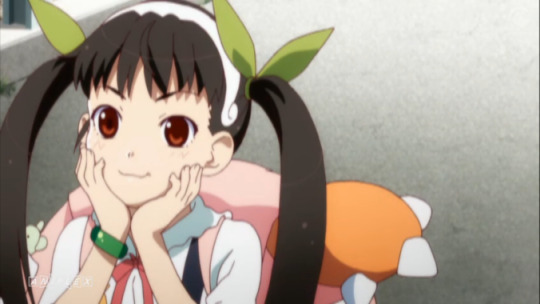
I would argue Mayoi Snail deviates in a similar manner, though not to such an obvious degree. Hitagi Crab is characterized by a darker, almost urban fantasy feel, full of religious artifacts and sobriety. Mayoi Snail jumps beyond that, presenting the viewer with a brighter and more satirical world (generally speaking). For this essay, I’ll just focus on the specifics of Suruga Monkey, rather than make a mess out of talking about everything. However, Mayoi Snail does exemplify the first major factor in this stylistic shift: the arc-specific opening themes.
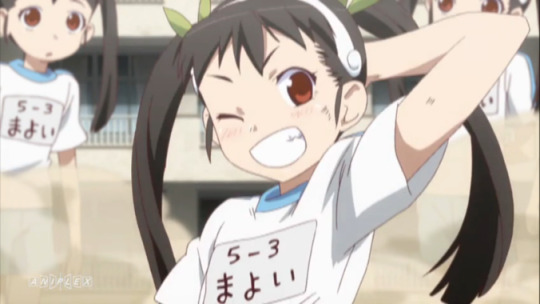
Mayoi Snail’s OP, with its electric pop and chant-able closing lines, does not fit the style or tone of Hitagi Crab whatsoever. It doesn’t even fit Mayoi Snail. The school life narrative told through the visuals is reminiscent of a middle school slice of life series, and even the lyrics are cute if you plead ignorance to the events of the arc. Of course, the visuals and lyrics convey a double meaning once we know Hachikuji is a ghost, but that’s a different matter. What’s important is that this OP primes us for a different world than what was established in the first arc. Mayoi Snail is sillier, more energetic, and probably closer to slice of life than urban fantasy (not that it’s strictly one or the other, or even either at all).
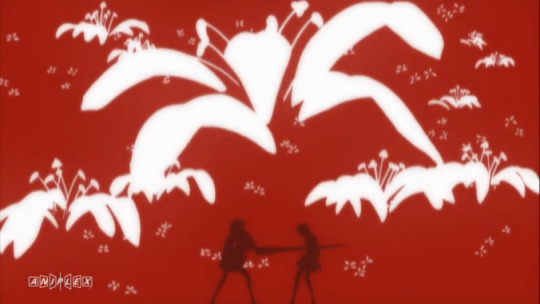
This trend repeats in Suruga Monkey’s OP, which starts with an upbeat guitar riff straight out of a Sonic game and a shot of a basketball hoop. Again, I won’t analyze every little detail here, but this sports anime theme continues for a bit before blending with rom-com visuals and music, as well as further action series signifiers (such as fast cuts, close-ups of eager eyes, etc.). Besides that, the Revolutionary Girl Utena—and other shoujo or yuri shows—influence becomes overwhelming at parts. Obviously this OP is distinct from Bakemonogatari’s first two, but it’s also distinct from the feel of either previous arc. Someone who has never seen Bakemonogatari will expect something based on Suruga Monkey’s OP that isn’t directly delivered upon anywhere in the series. But more on that soon.
Let’s actually backtrack a bit to examine some editing and form from the first couple of minutes of the arc’s first episode.
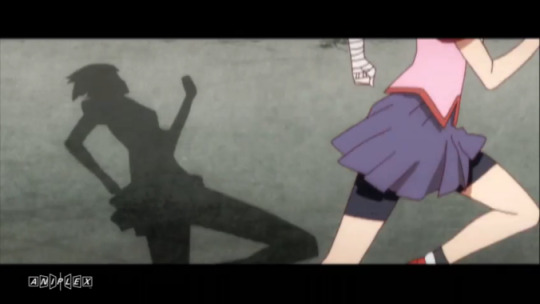
Here we see some clear examples of how Suruga Monkey bends or reshapes existing stylistic themes for the arc’s unique purpose. Right after the typical title card opener, the camera sweeps wildly in towards a railing. This is one of the few (if not only) legitimate camera movements in Bakemonogatari and immediately signals a more dynamic and action-focused experience. The next shot of Kanbaru sprinting and her feet slapping against the pavement continue to set the pace, so to speak. This same cut of Kanbaru sprinting is then interlaced throughout Araragi’s conversation with Hachikuji, constantly reminding us of that faster pace. Keep in mind that this kind of discontinuity/aspect editing is a staple of Monogatari, and thus preserves a sort of stylistic homeostasis even as we’re primed for action.
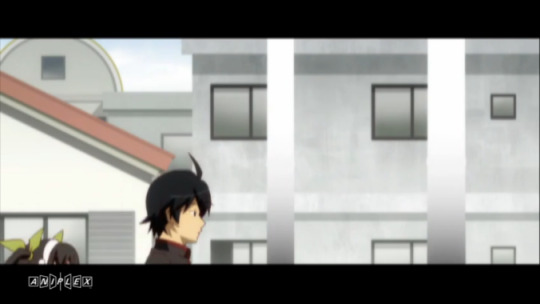
The shots and editing of the conversation itself work to further integrate the idea of dynamic action. As before, there’s nothing shockingly new, just old style repurposed for a new idea: action. Araragi and Senjougahara flip-flopped all over the screen in Mayoi Snail, but this sequence is more pointed than the park scene. Hachikuji and Araragi walk across a still background; then a moving background “walks” across them.
The walking shot is spread throughout the scene, and the pair make their way to the middle and then the end of the frame.
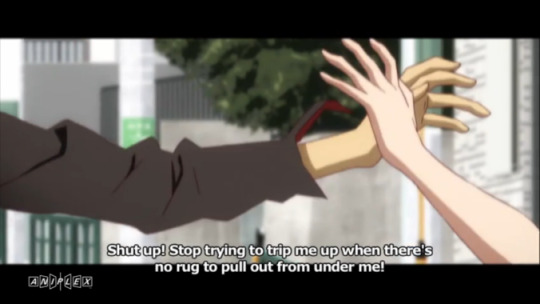
The cuts also are wilder, with still shots of Hachikuji transitioning to dynamic shots of Araragi falling. Even within still shots, there’s a step up in action in the form of railroad crossing lights flashing. Then, of course, are the shots of Araragi and Hachikuji slapboxing, which feature some of Bakemonogatari’s best (most fluid, at least) animation. Finally, Kanbaru herself comes flying into the scene. Even if I’m reading too much into some details, this opening scene is undoubtedly designed to allow this arc to transition to intense action scenes—such as Kanbaru and Araragi’s final fight—as smoothly as possible. If nothing else, it is no accident that so much effort was put into the slapboxing cuts. This arc needs movement, and we need to be ready for it.
I think of this as stylistic permeability—within the “body” of the art, different moods/tones or focal points can permeate out into observable territory with different degrees of ease. Monogatari has high permeability (dramatic soliloquys, bloody brawls, comedic conversations can all take center stage easily); something like Serial Experiment Lain has low permeability (even when characters make jokes, they still sound bleak or mysterious or otherwise unable to distinguish themselves from the overall dark mood). Permeability tends to be why we condemn certain tone shifts but not others. The formal elements that lead to permeability are too complex a topic for this essay, but the editing described above is one good example.
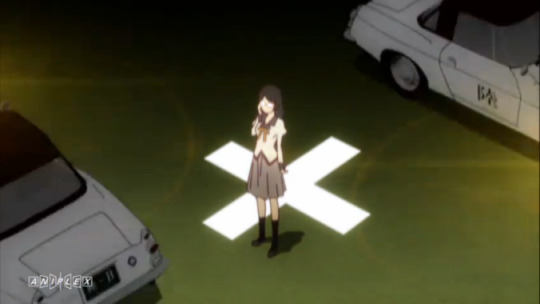
This permeability is insured throughout the arc via near-constant movement within the frame—whether that be moving cars or walking sequences like the one discussed above or even just a comedic camera pan. Action is likewise primed through Senjougahara’s eye-piercing aggression towards Araragi, which allows for a heightened state of excitement moving quickly into a sequence of Hanakawa standing in the middle of speeding traffic, and then finally the Rainy Devil’s attack on Araragi. True, Senjougahara was similarly violent in Hitagi Crab, but her aggression here still benefits the transition to intense action. The question isn’t whether these details are absolutely necessary to the transition or absolutely unique to this arc, but simply whether they increase permeability.
Perhaps most importantly, the source of the arc’s apparition is as emotionally intense as the action is physically. In Hitagi Crab and Mayoi Snail, apparitions cause trouble as a result of quiet emotions or even a relinquishment of emotion. Araragi simply doesn’t want to return home after an argument with his sisters (among other subtle discomforts), so he meets Hachikuji. Senjougahara tries to abandon her feelings towards her mother, so she meets a crab. Although Senjougahara reaches a melodramatic peak upon accepting her feelings, and Hachikuji (a wake-up call for Araragi) experiences the same upon arriving at home, neither the crab nor the snail exist as a medium for intense emotion. They aren’t inherently connected to a character’s fiery passions.
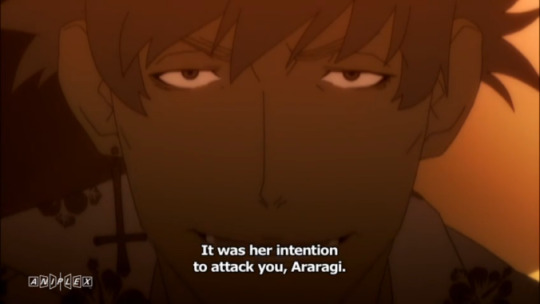
The Rainy Devil, however, becomes a problem precisely because of Kanbaru’s passions—her anger, jealousy, and hatred specifically. The Rainy Devil is the medium through which Kanbaru channels those emotions. The tool she uses, you could say. On a basic level, the crab and snail are not associated with intense emotions, but the Rainy Devil is. It couldn’t be associated with much of anything else! This small change in the context of the narrative is possibly the key for transitioning into Suruga Monkey while preserving cohesion. The formal/editing shifts explained above smooth out any bumps and sew it all together, but the actual cloth of the patchwork is this emotional/motivational adjustment.
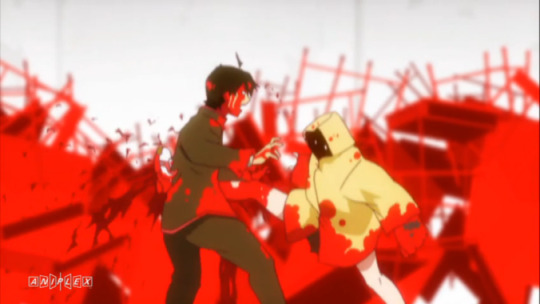
The actions and qualities of apparitions clue us into the psychological states of characters, and this is reflected directly in what we see on screen. I mean this quite literally. In Hitagi Crab, the grim hues, bizarre social interactions, and religious imagery result precisely from Senjougahara’s trauma. In Mayoi Snail, the vast emptiness of the park and the streets result precisely from Araragi wanting to be alone in the world. And in Suruga Monkey, the violence, speed, and overwhelming colors result precisely from Kanbaru’s jealousy and hatred. The inner and outer layers of the story and characters are bound together such that they demand this cohesion.
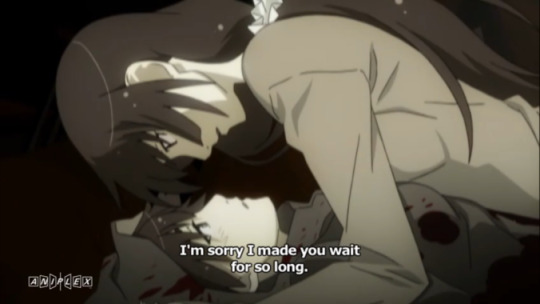
With the most intense action and violence spawning from the Rainy Devil, and snappy editing and dynamic cuts portraying said action, Suruga Monkey manages to transform our low-key psychological drama into something new. At its core, this arc is still Monogatari, so it’d be wrong to lump it in with other action or thriller or horror shows, but it is certainly distinct from its preceding arcs. Unique yet unifying, Suruga Monkey is a slam dunk.
Afternote:
I apologize for such an awful joke, but let me make up for it with some unnecessary analysis of a minor detail in the first episode of the arc. When Araragi and Senjougahara are studying together, Senjougahara is just writing the Gettysburg Address in English over and over again. I suppose it’s a decent speech to study if you’re learning English (middle schoolers all over America are forced to memorize it, after all), but I still found it a strange choice. So I decided to rationalize it by overanalyzing everything.
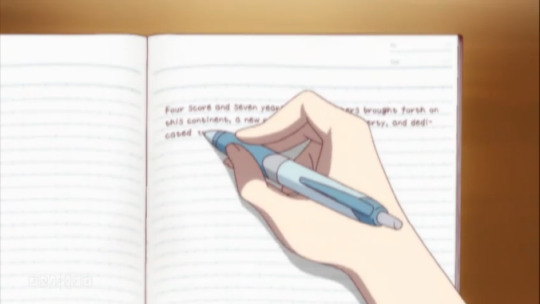
The Gettysburg Address was delivered by Abraham Lincoln during the American Civil War at the battlefield remains of Gettysburg. “Senjougahara” means battlefield, and we could consider the two halves of the Valhalla Combo like two halves of a nation. Senjougahara and Kanbaru split apart and one scorned the other, leading to something you might call a feud or fission. So: the battlefield of Gettysburg, the civil war of the Valhalla Combo…the Gettysburg Address?
I can’t imagine this being intentional, but if it is, then someone at SHAFT is as much of a madman as Isin himself.
Delayed by an impromptu drinking party and hangover, but here now (with a bonus!) Style in Bakemonogatari (Suruga Monkey) Suruga Monkey sets itself apart from the rest of Bakemonogatari by its execution.
2 notes
·
View notes
Text
Important conversations at the de Young
You can be part of it right now with the opening of the groundbreaking exhibition, Revelations: Art from the African American South on view until April 1, 2018.
Once again, the de Young is soaring to new and exciting heights in both their exhibitions and comprehensive collection of American Art (we get it already— you’re great). We’re not really complaining though, because what they’ve cooked up this time is a very necessary breath of fresh air.
This exhibition celebrates the de Young’s major acquisition of 62 works from contemporary African American artists from the Southern United States. The pieces came into the museum’s possession just four months ago, via The Souls Grown Deep Foundation in Atlanta, and the exhibition opens early this month. It only took them FOUR months to put together a comprehensive, thoughtful exhibition that spans seven galleries. In other words, they needed to get a move on, and coincidentally, so do you if you want to see this landmark exhibition.
Serious moment alert!
These galleries highlight a visual language that was established by a group that was being oppressed and stripped of basic human rights, and so they chose creation as a way to cope with the injustices they were facing everyday. Today, these works celebrate the resiliency of the human spirit and of people that, despite adversity, have held tight to their values and culture; they give a voice back to those who historically weren't given the privilege of speaking up. There may be graphic or disturbing imagery for some folks so fair warning. ~Okay, serious moment over~
Revelations has a little bit of everything: sculpture, textiles, assemblage (hoity toity term for putting a bunch of 3-D objects on a canvas), you name it. However, since it debuts some lesser known artists, it may be hard to wrangle your squad into going with you to see it, especially when you’re competing with Munch at the SFMOMA and Dorothea Lange across the bay at the Oakland Museum, but fight the museum fatigue(!) because we can say with confidence that this show is not to be missed (for starters, it’s the first of its kind in the area— a de Young™ original). Although there may be some coercing required to make the journey over to the park, you mustn't fear, as I’m here to come to your rescue by putting faces to names and giving you the top reasons that you should get in the car—or bike, walk, cable car, whatever works—and GO, GO, GO to the de Young immediately.
1. There’s an artist you may not have heard of whose work is beyond mesmerizing.
Thornton Dial, Sr. is often compared to Jackson Pollock for his erratic, splish splash painting style and “leave it all on the canvas” attitude. It’s not necessarily fair, however, to say that Pollock influenced Dial’s contemporary pieces, as the latter has always made a point of staying blissfully unaware of the history of art. When he first started out, he felt that he was just making "things."
10 points to whoever can tell me what this is made out of.
*drum roll* wood, wire, chair caning and cloth. Dial really takes the “where’s waldo” approach and makes you dig deep to figure out his pieces. The coolest part about them? They are SO fun to look at. It’s hard to tell unless you see them in person, but these sculpture-painting hybrids seem ready to jump off of the wall and I had the absolute hardest time reigning in my impulse to touch them. PSA: Don't touch the art, unfortunately.
New Light (2004) was made in reference to the sad fact that African American communities in the South were some of the last ones to receive basic utilities like electricity (Dial didn't see it until he was ten years old). The foundational structure of a picket fence symbolizes segregation and life in rural Alabama. The electrical wire that he’s attached in an almost bird’s nest clump, again, represents this glaring inequality as well as the relief that they felt when electricity was installed, finally making it possible for young children to do their homework in the light.
2. You may or may not see some real skeletons
No actual cows were harmed in the making.
In case you didn't catch our Instagram story from the press preview, I thought I should let you know about this striking piece that also made me slightly squeamish. This is the work of Thornton Dial again but in 360 degrees. Tada! He didn't only do sculptural-painting-sculptures, but also real sculpture-sculptures...Uhh anyway, this piece is made from real cow bones that he painted white before mounting them together into this composite sculpture, Lost Cows (2000-2001). It also includes such objects as golf balls, bags, mirrors, and enamel.
Dial drew this broad theme of life and death from his childhood working on a farm. There's a human skeletal form in the back that struggles to control his herd of white cows, representing how the white man would have been lost without African Americans to be the laborers, cooks etc.
Hey lil' buddies, photo via de Young
3. You’ve never seen quilts as colorful as these
Fiber arts meets smooth jazz riffs, image via Souls Grown Deep
The exhibition also highlights the strong tradition of quilt making that developed around 1859 in Gee's Bend, a small rural town in Alabama, and incorporated pieces of everyday life.
This quilt, Bars and String-Pieced Columns (1950s), was made by Jessie T. Pettway, aka Bootnie, who learned quilt making at a young age from her aunt. Fabric was scarce, so they used whatever they could scrounge up—old khaki t-shirts and torn-up overalls—which often ended up being clothes that they wore while working in the fields. She almost never used patterns. Instead, she improvised her vibrant compositions, asserting that, "[she] couldn't buy pretty materials, so [she] couldn't make pretty patterns." Fun fact: this quilt was featured on a 2006 postage stamp commemorating the Gee's bend quilters.
4. Or quilts used to make prints
This is not a quilt. (lol @ Duchamp jokes), photo via Artsy
It is, in fact, just an impression of a quilt. More specifically, this is a print that was made by sewing a miniature quilt, pressing the surface down into a soft ground, and then coloring it. This took an already very familiar medium and elevated it to an entirely new level of abstract, colorful goodness. This process was actually initiated by Pam Paulson, a Berkeley artist who brought a few of these master quilt makers to her studio to introduce them to printmaking in 2005.
Lonnie Holley made the print featured above, Coming out of the Redwoods, after a 2013 trip to the redwoods in Humboldt, CA (not too far from the Sartle office in SF!). Holley took this process a step further by incorporating found objects and scraps that he found inside and outside of the printmaking studio.
5. There’s an El Anatsui
Enough said— those sultry, undulating golden hills are enough to get me off of the couch any day, any time. Go see this beaut, Hover II (2004), in person today!
If this wasn't convincing, you can check out the digital preview on the de Young's website. I can't stress enough how poignant this exhibition is, as it debuts an entire group of American artists that have been otherwise ignored by the strong arm of art history. We're (re) writing history here, folks!
Let us know what stands out to you by tagging us in your photos from the exhibition on Twitter with @sartle or Instagram with @sartle.arthistory. We can't wait to hear what you think!
Photos and text by Rose
By: Rose Cannon
#art news#de young museum#art history#press preview#san francisco#art museums#african art#african american art#black art#sartle news
0 notes
Text
LVLSRVRYHI-044: Spurz
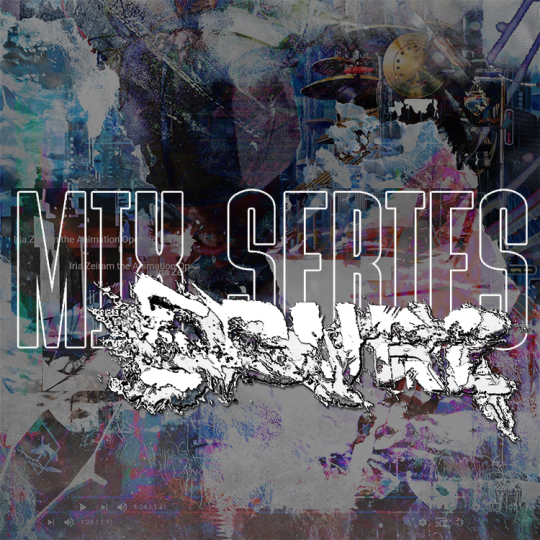
Hey man, how it's going? I usually start off with introductions, so, for anyone who doesn't know, who are you and where are you from? I'm Spurz, a producer/DJ originally from a small town in Canada, now based in London because I felt like my life needed a shake up and I wanted to chase some things I love. Aside from my own music, I also run a label called Drama Hands with one of my best friends, Jesse.
Now that you're in London you're ostensibly within spitting distance of places where a lot of your musical touchstones (grime, dubstep, jungle, garage) were born and developed - Was that a part of the decision behind the move? Did you come with specific expectations? Yeah, honestly that was kinda the biggest reason for the move. I was growing very disheartened by an increasingly bleak music/club scene in Vancouver where I've been for the past few years, but I'm a firm believer in the idea that if you don't like your situation or surroundings, you change them. More than that, I really wanted to experience firsthand not only the birthplace of all these sounds and scenes I cherish, but to better understand the societal factors that influenced their conception. I didn't move over with any concrete expectations besides the rent being pretty astronomical, but having a really solid network of London-based friends that I speak to on a regular basis helped give me an idea of what life was going to look like.
I mentioned the UK dance spectrum already, but something I've noticed just from hanging around you a lot lately is the breadth and depth of your listening habits; from Carly Rae Jepson to Lorenzo Senni to house and techno tracks I'm not even going to pretend to know. What were some of your first beginnings with music, electronic or otherwise? Is there anything you've revisited recently that's left an impact? I owe a lot of those eclectic tastes to my parents. My dad holds Delta blues musicians in the same light that people worship saints, while my mum worked the pop spectrum from the ‘50s onwards. Mum accidentally turned me on to electronic music, actually. She used to instruct aerobics classes and was always on the hunt for music with a solid beat, which at that time (mid 90's) meant a lot of "dance music" (the catch-all term at the time). The fact that she openly hated it all, referring to it as "circle music", made it extra appealing to me in the same way some kids gravitate to punk or metal. There was an underground rave DJ in Toronto, Chris Sheppard, who used to put out these Pirate Mix cassettes that I used to horde as soon as she bought them, that was really the entry point for me. While they had some questionable Eurodance content, they also had a lot of house and rave classics that served as a great gateway.
As for retrospection, I've been diving back into the LOL Boys catalogue. A lot of their productions were transformative for me, and there was something innocent and explorative about that time in electronic music, at least for me, and I miss it sometimes. Their Fader mix is one of the only mixes I ever revisit with any frequency.
Once I hear it I'm sure I'll start to pick out elements of that erratic taste of yours on your album - Loud Futures (which just dropped on Apothecary Compositions) - but if you had to give a sort of elevator pitch for the record what would be the main points to mention? It's mainly a study in contrasts, whether it be weight, textures, tones, etc. I suppose it's meant to be a more cohesive narrative, repurposing fragments of my influences while aiming for something that sits slightly out of any one pocket.
What brought you to release on Apothecary? Why the effort to put something physical out as well? Joseph (Druid Cloak) has been a friend and huge inspiration to me for years, not only as a producer but as an example of an artist who isn't afraid to put his vision and values above everything else. He was an early supporter of my music and it had always been a goal to work with him in some capacity. In a night of mutually drunken text messaging, we started bouncing around the idea of doing a full LP.
The physical element stems entirely from my younger days. I fully endorse digital consumption of music, but part of me will never be able to fully divorce from the feeling of owning a physical recording as an immersive experience. For this release, it was a great opportunity to add some extra layers to the record, and having my dear friend Markus Garcia (former LOL Boy, now Heartbeat(s)) supply his art on the project makes it really personal for me.
Drama Hands, the label and club night you co-run with your house/soulmate Jesse Rhodes, moved its operation to London the same time the two of you did. How do you see this change of base affecting something that started out as a specific response to the absence of a local scene or platform? Where do you plan to take the label now that you're here? You're right, it is a bit of a 180. Drama Hands was born out of a complete lack of spaces for local artists we loved that needed a platform. Even though we've moved to a place with one of the biggest possible platforms (albeit with ever-dwindling spaces), I think our goal is still very much the same. I feel that with the brighter spotlight London offers to some, it means others get left in even darker shadows, so we'd like to continue to help amplify the voice of artists we believe in. Our club nights will be up and running in London soon, and I'm excited about some of the upcoming projects we've got in the wings as well.
With both Drama Hands and Loud Futures in mind, I wanted to ask about what kind of influences you might have outside of music, and also how you adapt or recast those within your productions? A lot of my influences are actually spaces and moments, I write a lot of music to be a score to small, passing everyday scenes or structures. I'm inspired heavily by design, architecture and fashion, so in a way, my music is a way to build and sew in a sonic medium.
Where and how did you record the mix? Did you set out with any particular idea when picking out the tracks? The mix was recorded in my flat, on Ableton, which I tend to shy away from usually, but for mixes such as this one, I view them as a statement or composition, so I can add extra elements and utilize the elasticity that Ableton provides. Track selection was basically like any of my DJ sets, random grab bag of tracks I've been enjoying lately with a few older tracks peppered in. For me, nostalgia is an extremely powerful emotion when I'm on the dance floor so I usually try to work something timeless into my sets.
What else do you have planned for 2017? A bit later in the year, I'll be releasing a mixtape/cassette of productions titled 'Vexed 2 Rest On U'. I'm hoping to follow that up with a small collection of my writings accompanied by a sibling collection of more ambient works. A few other EPs/projects in the works for Drama Hands and some other labels too.
And finally, if you had to pick something for people to listen to immediately after this mix what would it be? If you enjoyed the Jungle / DnB direction the mix was headed in, I'd highly recommend revisiting some of the earlier Moving Shadow catalogue.
youtube
If you'd like to cool off, Steven Hauschildt's newest one 'Strands' is fantastic, as is Emika's new 'Melanfonie' project.
youtube
#Spurz#Apothecary Compositions#Loud Futures#Mix#Interview#words#the levels are very high#lvlsrvryhi#mix series#garage#grime#dubstep#jungle
0 notes
Text
Style in Bakemonogatari (Suruga Monkey)
Suruga Monkey sets itself apart from the rest of Bakemonogatari by its execution. Where Hitagi Crab is slim and slick, and Mayoi Snail is careful and cryptic, Suruga Monkey is simply bombastic. The arc expands Monogatari’s stylistic palette, while managing not to take any sharp tonal turns or compromise on the artistic cohesiveness of the series. This allows for Kanbaru’s character and the events of the arc to flourish in their own unique way without seeming out of place. Suruga Monkey feels like a natural extension of the series, yet also different from anything we’ve experienced so far.
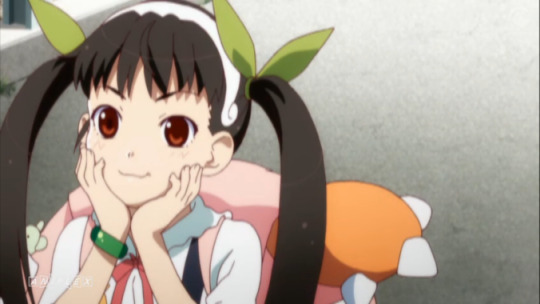
I would argue Mayoi Snail deviates in a similar manner, though not to such an obvious degree. Hitagi Crab is characterized by a darker, almost urban fantasy feel, full of religious artifacts and sobriety. Mayoi Snail jumps beyond that, presenting the viewer with a brighter and more satirical world (generally speaking). For this essay, I’ll just focus on the specifics of Suruga Monkey, rather than make a mess out of talking about everything. However, Mayoi Snail does exemplify the first major factor in this stylistic shift: the arc-specific opening themes.
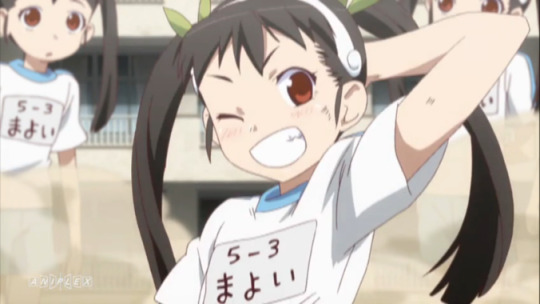
Mayoi Snail’s OP, with its electric pop and chant-able closing lines, does not fit the style or tone of Hitagi Crab whatsoever. It doesn’t even fit Mayoi Snail. The school life narrative told through the visuals is reminiscent of a middle school slice of life series, and even the lyrics are cute if you plead ignorance to the events of the arc. Of course, the visuals and lyrics convey a double meaning once we know Hachikuji is a ghost, but that’s a different matter. What’s important is that this OP primes us for a different world than what was established in the first arc. Mayoi Snail is sillier, more energetic, and probably closer to slice of life than urban fantasy (not that it’s strictly one or the other, or even either at all).
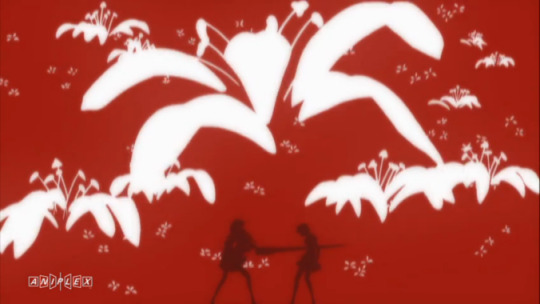
This trend repeats in Suruga Monkey’s OP, which starts with an upbeat guitar riff straight out of a Sonic game and a shot of a basketball hoop. Again, I won’t analyze every little detail here, but this sports anime theme continues for a bit before blending with rom-com visuals and music, as well as further action series signifiers (such as fast cuts, close-ups of eager eyes, etc.). Besides that, the Revolutionary Girl Utena—and other shoujo or yuri shows—influence becomes overwhelming at parts. Obviously this OP is distinct from Bakemonogatari’s first two, but it’s also distinct from the feel of either previous arc. Someone who has never seen Bakemonogatari will expect something based on Suruga Monkey’s OP that isn’t directly delivered upon anywhere in the series. But more on that soon.
Let’s actually backtrack a bit to examine some editing and form from the first couple of minutes of the arc’s first episode.
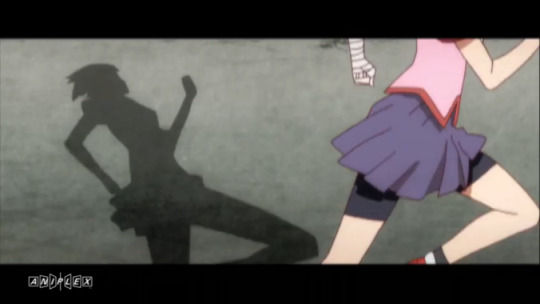
Here we see some clear examples of how Suruga Monkey bends or reshapes existing stylistic themes for the arc’s unique purpose. Right after the typical title card opener, the camera sweeps wildly in towards a railing. This is one of the few (if not only) legitimate camera movements in Bakemonogatari and immediately signals a more dynamic and action-focused experience. The next shot of Kanbaru sprinting and her feet slapping against the pavement continue to set the pace, so to speak. This same cut of Kanbaru sprinting is then interlaced throughout Araragi’s conversation with Hachikuji, constantly reminding us of that faster pace. Keep in mind that this kind of discontinuity/aspect editing is a staple of Monogatari, and thus preserves a sort of stylistic homeostasis even as we’re primed for action.
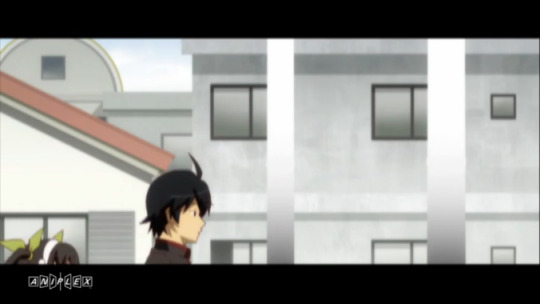
The shots and editing of the conversation itself work to further integrate the idea of dynamic action. As before, there’s nothing shockingly new, just old style repurposed for a new idea: action. Araragi and Senjougahara flip-flopped all over the screen in Mayoi Snail, but this sequence is more pointed than the park scene. Hachikuji and Araragi walk across a still background; then a moving background “walks” across them.
The walking shot is spread throughout the scene, and the pair make their way to the middle and then the end of the frame.
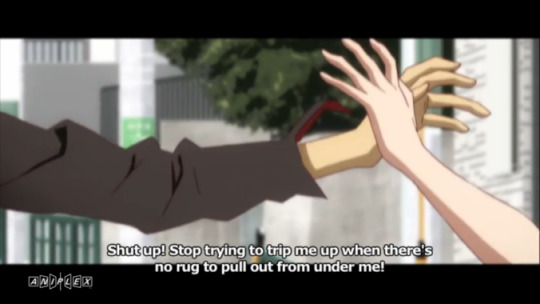
The cuts also are wilder, with still shots of Hachikuji transitioning to dynamic shots of Araragi falling. Even within still shots, there’s a step up in action in the form of railroad crossing lights flashing. Then, of course, are the shots of Araragi and Hachikuji slapboxing, which feature some of Bakemonogatari’s best (most fluid, at least) animation. Finally, Kanbaru herself comes flying into the scene. Even if I’m reading too much into some details, this opening scene is undoubtedly designed to allow this arc to transition to intense action scenes—such as Kanbaru and Araragi’s final fight—as smoothly as possible. If nothing else, it is no accident that so much effort was put into the slapboxing cuts. This arc needs movement, and we need to be ready for it.
I think of this as stylistic permeability—within the “body” of the art, different moods/tones or focal points can permeate out into observable territory with different degrees of ease. Monogatari has high permeability (dramatic soliloquys, bloody brawls, comedic conversations can all take center stage easily); something like Serial Experiment Lain has low permeability (even when characters make jokes, they still sound bleak or mysterious or otherwise unable to distinguish themselves from the overall dark mood). Permeability tends to be why we condemn certain tone shifts but not others. The formal elements that lead to permeability are too complex a topic for this essay, but the editing described above is one good example.
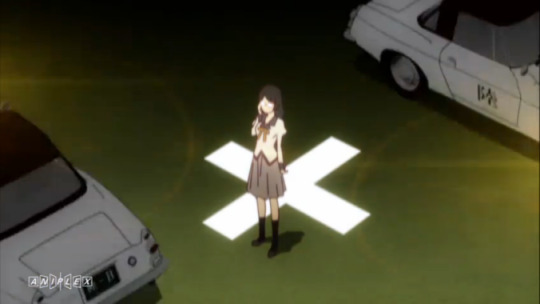
This permeability is insured throughout the arc via near-constant movement within the frame—whether that be moving cars or walking sequences like the one discussed above or even just a comedic camera pan. Action is likewise primed through Senjougahara’s eye-piercing aggression towards Araragi, which allows for a heightened state of excitement moving quickly into a sequence of Hanakawa standing in the middle of speeding traffic, and then finally the Rainy Devil’s attack on Araragi. True, Senjougahara was similarly violent in Hitagi Crab, but her aggression here still benefits the transition to intense action. The question isn’t whether these details are absolutely necessary to the transition or absolutely unique to this arc, but simply whether they increase permeability.
Perhaps most importantly, the source of the arc’s apparition is as emotionally intense as the action is physically. In Hitagi Crab and Mayoi Snail, apparitions cause trouble as a result of quiet emotions or even a relinquishment of emotion. Araragi simply doesn’t want to return home after an argument with his sisters (among other subtle discomforts), so he meets Hachikuji. Senjougahara tries to abandon her feelings towards her mother, so she meets a crab. Although Senjougahara reaches a melodramatic peak upon accepting her feelings, and Hachikuji (a wake-up call for Araragi) experiences the same upon arriving at home, neither the crab nor the snail exist as a medium for intense emotion. They aren’t inherently connected to a character’s fiery passions.
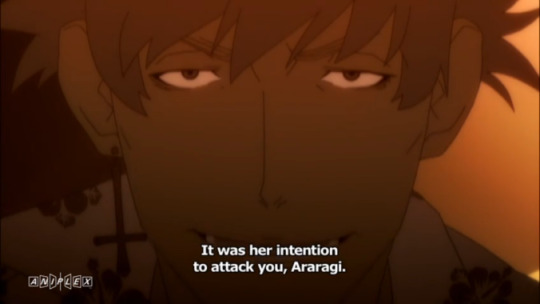
The Rainy Devil, however, becomes a problem precisely because of Kanbaru’s passions—her anger, jealousy, and hatred specifically. The Rainy Devil is the medium through which Kanbaru channels those emotions. The tool she uses, you could say. On a basic level, the crab and snail are not associated with intense emotions, but the Rainy Devil is. It couldn’t be associated with much of anything else! This small change in the context of the narrative is possibly the key for transitioning into Suruga Monkey while preserving cohesion. The formal/editing shifts explained above smooth out any bumps and sew it all together, but the actual cloth of the patchwork is this emotional/motivational adjustment.
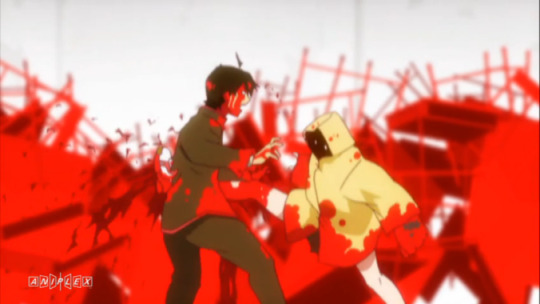
The actions and qualities of apparitions clue us into the psychological states of characters, and this is reflected directly in what we see on screen. I mean this quite literally. In Hitagi Crab, the grim hues, bizarre social interactions, and religious imagery result precisely from Senjougahara’s trauma. In Mayoi Snail, the vast emptiness of the park and the streets result precisely from Araragi wanting to be alone in the world. And in Suruga Monkey, the violence, speed, and overwhelming colors result precisely from Kanbaru’s jealousy and hatred. The inner and outer layers of the story and characters are bound together such that they demand this cohesion.
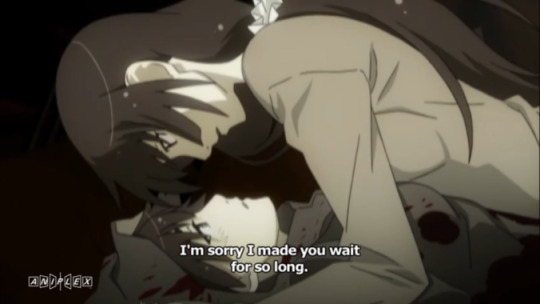
With the most intense action and violence spawning from the Rainy Devil, and snappy editing and dynamic cuts portraying said action, Suruga Monkey manages to transform our low-key psychological drama into something new. At its core, this arc is still Monogatari, so it’d be wrong to lump it in with other action or thriller or horror shows, but it is certainly distinct from its preceding arcs. Unique yet unifying, Suruga Monkey is a slam dunk.
Afternote:
I apologize for such an awful joke, but let me make up for it with some unnecessary analysis of a minor detail in the first episode of the arc. When Araragi and Senjougahara are studying together, Senjougahara is just writing the Gettysburg Address in English over and over again. I suppose it’s a decent speech to study if you’re learning English (middle schoolers all over America are forced to memorize it, after all), but I still found it a strange choice. So I decided to rationalize it by overanalyzing everything.
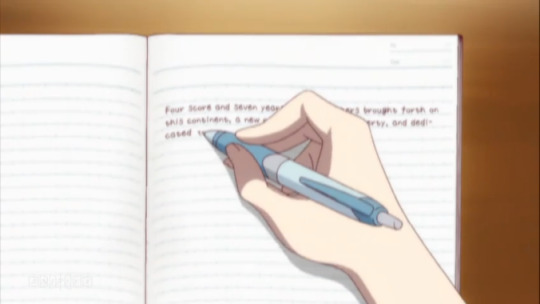
The Gettysburg Address was delivered by Abraham Lincoln during the American Civil War at the battlefield remains of Gettysburg. “Senjougahara” means battlefield, and we could consider the two halves of the Valhalla Combo like two halves of a nation. Senjougahara and Kanbaru split apart and one scorned the other, leading to something you might call a feud or fission. So: the battlefield of Gettysburg, the civil war of the Valhalla Combo…the Gettysburg Address?
I can’t imagine this being intentional, but if it is, then someone at SHAFT is as much of a madman as Isin himself.
Delayed by an impromptu drinking party and hangover, but here now (with a bonus!) Style in Bakemonogatari (Suruga Monkey) Suruga Monkey sets itself apart from the rest of Bakemonogatari by its execution.
1 note
·
View note